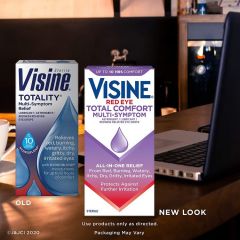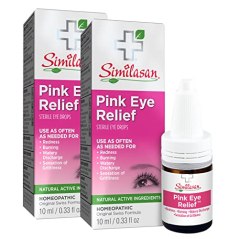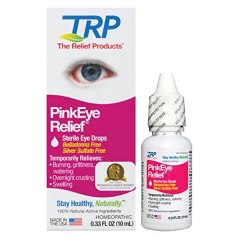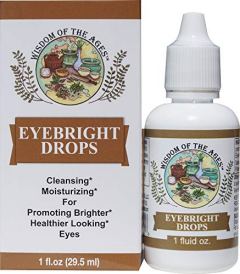BestReviews is reader-supported and may earn an affiliate commission. Details

These eye drops provide quick relief from watery, red, burning, and itchy eyes, and help prevent further agitation.
This formula is an all-in-one multi-symptom astringent and lubricant that helps protect the eyes from further irritation. It's made from a blend of zinc sulfate, polyethylene glycol & tetrahydrozoline. Works for up to 10 hours.
Additional dosing may be required beyond the specified instructions.

These eye drops offer temporary relief from burning and facilitates long-lasting comfort.
Fast-acting eye drop cools and refreshes eyes. Relieves dryness while soothing minor eye irritations. Helps to bring instant cooling. Easy to use. Help combat dryness and irritation due to screen exposure.
A bit expensive for the quantity offered.

This homeopathic formulation provides temporary relief from symptoms and can be used as often as needed.
Uses natural active ingredients to stimulate the body's defenses against pink eye. Provides temporary relief from itching and burning. Use as often as needed. Helps with pink eye, dry eye, and histamine reactions.
Manufacturer advises to discard any unused portion after 30 days. Homeopathic products may not work for all people.

This product may not get rid of pink eye but it helps to relieve symptoms while you're waiting to see the doctor.
Homeopathic formula stimulates body's ability to relieve symptoms. Helps temporarily reduce redness, burning, watering, swelling, and overnight crusting. May also help relieve symptoms from sties.
Intended to relieve symptoms, but may not be able to get rid of infection. Manufacturer advises to discard after 30 days.

Made with an herbal extract believed to support vision, this is thought to help treat many eye problems, including conjunctivitis.
Glycerin-based formula combines organic eyebright extract with benefits of sea salt, MSM, apple cider vinegar, and grapefruit seed extract. Helps relieve eye ailments like conjunctivitis, other eye irritations, and eye strain.
May initially sting irritated eyes, but this goes away quickly.

We recommend these products based on an intensive research process that's designed to cut through the noise and find the top products in this space. Guided by experts, we spend hours looking into the factors that matter, to bring you these selections.

If you’ve ever suffered from pink eye, formally known as conjunctivitis, you know how uncomfortable this itchy, burning eye condition can be. In the throes of pink eye irritation, you may find yourself willing to take your fingernails to your own eyeballs just to get rid of the itch and discomfort. Don’t do that. Instead, get yourself some medical attention and, if appropriate, some over-the-counter drops for pink eye.
In this buying guide, we do not discuss prescription medication for pink eye. Rather, we present information about eye drops you can buy without the consent of a doctor. These drops will not cure your condition, but they can provide temporary relief until the irritation subsides on its own or you’re able to fill your doctor’s prescription.

Viral conjunctivitis, bacterial conjunctivitis, and allergic conjunctivitis: which type do you have?
Viral conjunctivitis is the most common pink eye affliction. It’s highly contagious, so if you develop burning, redness, or watery eyes after you’ve spent time in a crowded public place like a school or shopping center, you may have caught viral pink eye. Viral pink eye often occurs in just one eye.
There isn’t a “cure” for viral conjunctivitis. Your doctor may tell you to place a cool washcloth on your eyes, but this is just to alleviate symptoms. You can also try over-the-counter drops for pink eye.
Bacterial conjunctivitis is also highly contagious. You can easily pick up the bacteria from someone’s unwashed hands or your own dirty contact lenses. Symptoms include red, sore eyes that may ooze pus. Bacterial pink eye usually occurs in both eyes.
Antibiotic eye drops for bacterial pink eye can only be prescribed by your doctor. However, there are some over-the-counter drops for pink eye that can help alleviate the redness and other symptoms.
Allergic conjunctivitis is not contagious. Nevertheless, it’s highly uncomfortable, just like the other two types of pink eye. If you have puffy eyelids and/or itchy, red, watery eyes, you may have allergic conjunctivitis. In addition to prescription medication, there are a few types of over-the-counter eye drops you can take for allergic pink eye. These drops may include an antihistamine or a mast cell stabilizer, which helps halt the release of histamines.
In short, you may be able to treat your pink eye symptoms with over-the-counter drops, but you won’t be able to cure an infection with these drops.
Now let’s take a closer look at the ingredients found in over-the-counter drops for pink eye.
Your eyesight is precious, and it’s understandable that you wouldn’t want to put something in your eye without knowing what it is first. Many drugstore treatments for pink eye contain “all-natural” or “homeopathic” ingredients, but what are these substances?
Here are some of the most common ingredients found in over-the-counter drops for pink eye. Please note that this list is not comprehensive. Also note that some of the ingredients may pose health risks, especially if you are expecting a baby, nursing a baby, or in a state of compromised health.
Aconite: Derived from a genus of flowering plants, aconite is highly toxic, especially when fresh. If you’re pregnant or lactating, it’s extremely important that you do not use any product containing aconite. That said, the substance has been used for centuries in the treatment of certain health problems, including inflammation and cold symptoms.
Apis mellifica: This substance is either bee venom or a tincture that includes crushed honeybee(s). Often simply called “apis,” it is diluted many times over and is thought to relieve the very symptoms that a bee sting can cause: itching, burning, welting, and swelling.
Belladonna: This plant is also known as deadly nightshade, and it has a reputation for being poisonous. That said, it also has a reputation for alleviating the symptoms of pink eye and a host of other health problems, including nerve pain and hemorrhoids. Understandably, some consumers wish to avoid belladonna. In response, some companies specifically state on their packaging that their pink eye drops contain no belladonna.
Euphrasia: Also known as “eyebright,” euphrasia is a genus of flowering plant that has been used for centuries to treat cold and allergy symptoms. It’s sometimes packaged as a standalone herbal supplement. (Warning: do not apply undiluted eyebright directly to your eyes!) Eyebright is found in some over-the-counter pink eye preparations. Follow the directions carefully to avoid damaging your eyes.
MSM (methylsulfonylmethane): MSM is found naturally in some foods, including fruit and milk, but the concentration is not high enough to combat pink eye or other ailments. People have taken it in oral supplement form and also as a skin preparation with some success. For the treatment of pink eye, MSM is thought to soothe inflammation. Expectant and lactating mothers should not take MSM.
Pulsatilla nigricans: Derived from a plant, pulsatilla nigricans is thought to help combat the yellow ooze that accompanies some cases of pink eye. It is used in homeopathic medicine to treat a slew of problems, though no scientific evidence supports its use. In fact, pulsatilla is extremely dangerous for expectant mothers, as it can cause miscarriage or birth defects.
As you can see, these drops require some serious thought before you buy. Although there are health warnings for many homeopathic ingredients, it is ultimately up to you to determine what’s safe for you or anyone to whom you give these drops.
Once you’ve made the decision to purchase homeopathic drops for pink eye, it’s time to consider some product features.

Cotton ball: When you read the product specs for various pink eye drops, you’ll notice that some drops are meant to be applied to the outer eye area only. Although the product may come with an eye dropper, you may be instructed to moisten a cotton ball or pad with liquid and dab it on the outside of your eye. Follow these instructions to a tee, as you wouldn’t want to expose your eyeball to a substance meant only for your skin.
Eye dropper: Some drops are meant to be applied directly to the eye with an eye dropper. As with any eye drops, do not share the bottle with anyone else, as this is a surefire way to transfer germs from one person to another.
Other: Finally, as mentioned, there are some “drops” that are less like a liquid and more like an ointment. You may be instructed to apply the ointment to the eyelid or the eyeball. In either case, you will need a sterile method of application, whether via clean hands, a cotton swab, or another method.
Over-the-counter drops for pink eye should not be kept in your medicine cabinet indefinitely. The ingredients will expire, causing them to lose effectiveness and/or intensify adverse side effects. Some makers specify on the package that you should throw the contents away within 30 days after opening. Follow these guidelines. If the packaging does not specify an expiration date, assume that the shelf life is no more than 30 days.
When you purchase a product that is regulated by the FDA, you may receive a list of potential side effects in the packaging. However, when you purchase a homeopathic treatment like the ones we discuss here, you may not receive such a list. That doesn’t mean there aren’t potential side effects. Some negative side effects to look out for include the following:
Burning
Itching
Blurred vision
Headache
If your symptoms are severe and unrelenting, call 911. If you have any doubts about your safety or concerns about side effects you experience, stop using the product immediately and get medical help.
Cost depends more on quantity than anything else. You shouldn’t have to spend more than around $20 for one bottle of drops, and many products cost half that.
A smaller container of drops for pink eye (say 0.3 fluid ounce) is likely to cost between $6 and $12.
Often, you can buy low-cost drops for pink eye in multipacks. For example, a package of two 0.3-ounce bottles may cost you between $8 and $14. If two people are receiving treatment, this is a good idea because you shouldn’t share bottles of medicine.
A 1-ounce container of drops for pink eye could cost as much as $20 or $25.

Do not apply OTC pink eye drops to the eyes of companion animals. Although cats and dogs can get conjunctivitis, the treatments mentioned here could be fatal to them. Seek professional veterinary treatment.
If you contract pink eye, throw out all cosmetics that may have come into contact with your eye area. This includes mascara and eyeliner. If you don’t, you could inadvertently reinfect yourself.
Reinforce the importance of washing hands to little ones. There’s a reason pink eye runs rampant in schools: young kids aren’t always conscientious about cleaning their hands. Consider posting a sign on the bathroom mirror asking, “Did you wash your hands?”

A. You could, but the question is, would you want to? Pink eye is very uncomfortable. What’s more, if left untreated, bacterial conjunctivitis could permanently damage your eyes. Your symptoms could go on for ten days or more, too. We suggest you seek medical attention for bacterial pink eye.
A. In a manner of speaking, yes. Pink eye may be caused by bacteria, a virus, or an allergen. Contact lenses are susceptible to picking up all three, especially if they’re not properly maintained. If you develop symptoms of pink eye while wearing contact lenses, take them out. Don’t put them back in your eyes unless a doctor tells you it’s safe to do so.
A. It depends on your particular case. If you have bacterial or viral pink eye, you could be contagious for days or weeks. People with visible symptoms of pink eye may be more contagious. To prevent spreading germs, avoid situations in which you sit close to others or share writing utensils, keyboards, and other items.
Get emails you’ll love.
Learn about the products you’re wondering if you should buy and get advice on using your latest purchases.
